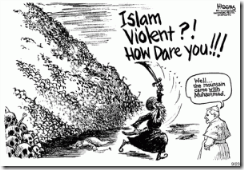Cross posted @ the Atheist Oasis  This is so disturbing on multiple levels…
This is so disturbing on multiple levels…
The terrifying rise of Isis: $2bn in loot, online killings and an army on the run
1. Who are they?
Isis is the (slightly confusing) English acronym for the Islamic State in Iraq and the Levant, a Sunni jihadist group whose sudden capture of Mosul, Tikrit and extensive swaths of Iraqi territory last week has triggered a new crisis, complete with atrocities targeting Iraqi army soldiers and volunteers. Known in Arabic as Da'ash, it grew out of the Islamic State in Iraq, an al-Qaida affiliate which, in turn, came into existence after the 2003 US-led invasion.
The leader or emir (prince) of Isis is a 43-year-old Sunni, known by his nom de guerre as Abu-Bakr al-Baghdadi, or Abu Dua. His real name is Awwad Ibrahim Ali al-Badri al-Samarrai. He was held prisoner by US forces from 2005 to 2009. US military sources have quoted him as saying when he was released from Camp Bucca in Iraq: "I'll see you guys in New York." According to some accounts he was radicalised by his experience of captivity. But others describe him as having been a firebrand preacher under Saddam Hussein's rule. He studied at the University of Baghdad, and was listed as a terrorist by the UN in 2011.
It is a measure of Baghdadi's success and charisma that Isis has become the group of choice for thousands of foreign would-be fighters who have flocked to his banner. Late last year, he announced the creation of a new group that would be merged with a rival al-Qaida affiliate active in Syria, Jabhat al-Nusra. That was disputed both by Nusra and Osama bin Laden's successor as the leader of al-Qaida "central", the Egyptian Ayman al-Zawahiri. Baghdadi, who has been described as more extreme than Bin Laden, refused an order from Zawahiri to focus the group's efforts in Iraq and leave Syria alone.
In the areas of Syria it controls, Isis has set up courts, schools and other services, flying its black jihadi flag everywhere. In Raqqa, it even started a consumer protection authority for food standards. It has established a reputation for extreme brutality, carrying out crucifixions, beheadings and amputations.
Estimates of Isis numbers range from 7,000 to 10,000. Its rank and file members are drawn from fighters who were previously with al-Qaida, some former Ba'athists and soldiers of the Saddam-era army. What is far harder to quantify – and a highly significant question – is how much support the group has from Iraq's wider Sunni community, the people who lost their power and influence when Saddam was overthrown.
"Isis now presents itself as an ideologically superior alternative to al-Qaida within the jihadi community," says Charles Lister, of the Brookings Doha Center. "As such, it has increasingly become a transnational movement with immediate objectives far beyond Iraq and Syria."
Worrisome? It gets worse:
2. What do they want and what's their link to al-Qaida?
Last February, al-Qaida disavowed Isis, saying it was "in no way connected to it", that it had not been informed of its creation, and was not responsible for its actions. Isis was deemed too extreme for al-Qaida.
The fallout between Isis and al-Qaida is not surprising. The ISI's methods and attitude – including indiscriminate bombings in civilian areas and the imposition of its harsh, ultraconservative interpretation of Islam – had long prompted debate within jihadi circles. Several of the letters found among the so-called Abbottabad papers (a stash of correspondence recovered from Bin Laden's Pakistani hideaway after his killing in 2011) question or criticise the group and warn that it might have a negative impact on al-Qaida's reputation.
In one 21-page letter, dated January 2011, the American jihadist Adam Gadahn advised the al-Qaida leadership to "declare its discontent with the behaviour … being carried out by the so-called Islamic State of Iraq, without an order from al-Qaida and without consultation". Al-Qaida didn't take Gadahn's advice. The rift only grew, spurred by the rise of Jabhat al-Nusra in Syria.
Although they are now open rivals, ironically all three groups – Jabhat al-Nusra and Zawahiri's al-Qaida on the one hand, and Isis on the other – share the same goals: the creation of an Islamic state in Syria (and Iraq) and the return of the borderless Islamic caliphate, which ended in 1924 after the fall of the Ottoman empire.
‘Too extreme for Al-Qaida?’ Can you say “Uh-oh”, boys and girls?
3. Where does Isis get its money from?
Since the end of 2011, Islamic charities and rich individuals in the gulf have been funding insurgent groups in Syria. As the role of Islamist groups within or linked to Jabhat al-Nusra and Isis has grown, many of these donors have directly or indirectly provided money that reaches jihadist organisations. According to a policy briefing by the Brookings Doha Center last month, much of the charity-based and private fundraising for the insurgency in Syria focuses on particular areas of the country, most of which involve jihadists.
Until late last year, it was possible to find the international depository banking details for donations. Now this has been replaced by mobile phone contact information and WhatsApp accounts used to coordinate donations and sometimes even physical street addresses from where the money is collected.
Isis has secured massive cashflows from the oilfields of eastern Syria, which it had commandeered in late 2012, some of which it sold back to the Syrian regime. It has also made money from smuggling raw materials pillaged in Syria as well as priceless antiquities from archeological digs. An intelligence official told the Guardian that Isis took $36m from al-Nabuk, an area in the Qalamoun mountains west of Damascus, including antiquities that are up to 8,000 years old.
Computer sticks taken from an Isis courier by Iraqi forces before the fall of the northern city of Mosul revealed that Isis – before the city's capture – had cash and assets worth $875m (£516m). After the fall of Mosul, Isis looted the banks and captured military supplies that have boosted the group's coffers to about $2bn, according to Iraqi officials.
Gulf donors support Isis out of solidarity with fellow Sunnis in Syria as President Bashir al-Assad has unleashed his military to crush opposition to his rule. The US has tried to put pressure on the governments in Saudi Arabia, Kuwait and Qatar to crack down on funding for extremist groups, but these regimes say donors are justified in backing rebel forces in Syria because the US failed to act against Assad, especially when he crossed the "red line" laid down by President Barack Obama with the use of chemical weapons.
Two billion dollars is a lot of cabbage. Oil money combined with grand theft to spearhead religious fanatics. Always a bad recipe.
Now here’s the scarier part:
4. How do they use social media and how effective is their campaign?
Jihadists have always embraced technology. Ever since 9/11, the global jihad movement has used the internet to disseminate information, create its own narrative and incite supporters.
The traditional repository of this activity was password-protected forums where jihadists and their supporters could be connected in a safe environment to share information and discuss events. Most importantly, it allowed forum administrators to control the debate by deleting problematic posts and suspending troublesome users.
Web forums are less important these days, giving way to platforms such as Twitter, Facebook and Instagram. In this respect, Isis has harnessed the power of these platforms better than any other jihadist movement today. Online, it has created a brand, spread a seductive narrative and employed powerful iconography. This strategy has been responsible for inspiring thousands of men from all over the world to join the group.
But Isis also realises that it cannot control the narrative the way its predecessors once could. Social media, coupled with the ubiquity of smartphones, has meant that individual fighters can now film and upload events to the internet in an instant, often with little thought. Isis is not always happy about this. Just a few weeks ago, the group crucified two men in Manbij, Syria, for alleged apostasy (although supporters say the men were regime spies). A Spanish foreign fighter who had promised his followers a video of the spectacle had to make do with only providing pictures of the sadistic act. "Our leadership forbade anyone from filming it," he said.
This is not the first time Isis has warned its members about their online activity. Earlier this year, the group chopped off the hand of a man in Raqqa. It was a dark, torrid affair with the swordsman requiring several attempts before finally severing the man's hand. After understandable public outcry, the group has now prohibited anyone from filming similar events. It still goes on, of course, but anyone brandishing a smartphone will be censured.
In many senses, this represents the "pluralising" of the global jihad. Whereas we had one or two voices to analyse in the past, we now have hundreds. Individual fighters offer a stream of consciousness from their world, tweeting about their experiences, sharing pictures of daily life and bragging about their military accomplishments. These men are frequently unguarded and clumsy, offering an insight into parts of Isis that the group would no doubt rather keep hidden.
Putting these accounts into perspective is important. Although Isis maintains an institutional presence on social media, far more popular are the personal accounts of individual fighters or "disseminators" – sympathetic individuals (typically based in the west) who tweet in support of the group and its aims. These disseminators are among the most vociferous and zealous activists, compensating for their absence on the battlefield with their ferocious support online.
We often talk about the "social media strategy" of jihadist groups. At the official level, with institutional accounts, there is clearly a plan: to rebut criticism, promote the group's narrative, and spread its image as a benevolent vanguard. They recognise this as a necessity. But savvy organisations such as Isis are also acutely aware of the dangers of allowing individual fighters unfettered access to social media. The real challenge for these groups in future years will not be how they use the internet, but how well they can manage it.
Smart sociopaths. Oh joy.
Is this then the price we pay for accommodating these nutjobs? Driven crazy by too much sun, sand-drenched pores, little to no sex, and blindly following the teachings of a fraudulent, illiterate pedophiliac from the 5th century, do these hairy-eyed lunatics represent our future, one of a Sharia-driven government, a theocracy from the dankest dungeon of medieval times?
They will take my democracy when they pry it from my cold, dead fingers.
Ideological mad dogs are in the same slot as real ones: they need to get put down.
Till the next post, then.














No comments:
Post a Comment